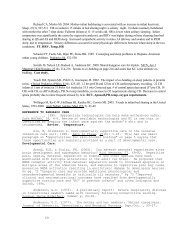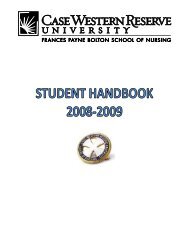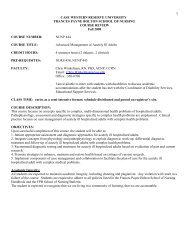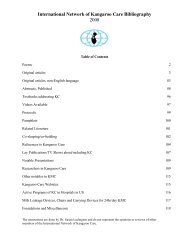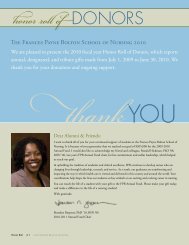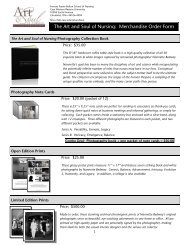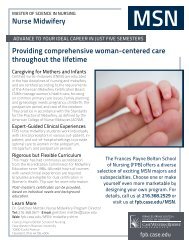Shared Governance and Empowerment in Registered Nurses ...
Shared Governance and Empowerment in Registered Nurses ...
Shared Governance and Empowerment in Registered Nurses ...
You also want an ePaper? Increase the reach of your titles
YUMPU automatically turns print PDFs into web optimized ePapers that Google loves.
LWW/NAQ NAQ200100 May 28, 2011 3:7<br />
<strong>Shared</strong> <strong>Governance</strong> <strong>and</strong> <strong>Empowerment</strong> <strong>in</strong> <strong>Registered</strong> <strong>Nurses</strong> 215<br />
empowerment among nurses work<strong>in</strong>g <strong>in</strong> an<br />
acute hospital sett<strong>in</strong>g. Kanter’s structural theory<br />
of empowerment was the conceptual<br />
framework for the study conducted <strong>in</strong> a large<br />
tertiary care hospital located <strong>in</strong> Queens, New<br />
York. The purposive sample <strong>in</strong>cluded 348<br />
nurses work<strong>in</strong>g <strong>in</strong> the study site facility <strong>in</strong> 13<br />
units that had a shared governance model <strong>in</strong><br />
place for at least 6 months to 1 year. The study<br />
units <strong>in</strong>cluded medic<strong>in</strong>e, surgery, neurology,<br />
orthopedics, oncology, <strong>and</strong> cardiology. The<br />
total number of nurses that participated was<br />
158. The participants completed 2 surveys:<br />
the Index of Professional Nurs<strong>in</strong>g <strong>Governance</strong><br />
<strong>and</strong> the Conditions of Work Effectiveness II<br />
Questionnaire (CWEQ-II).<br />
Data were analyzed us<strong>in</strong>g Statistical Analysis<br />
Software (IBMSPSS, Armonk, New York)<br />
to evaluate the research question. Descriptive<br />
statistics were used to describe the sample.<br />
Frequency distributions were utilized to describe<br />
the percentage of RNs for each categorical<br />
background variable (gender, age, basic<br />
nurs<strong>in</strong>g educational preparation, highest<br />
educational preparation, employment status,<br />
years practic<strong>in</strong>g nurs<strong>in</strong>g, present position <strong>in</strong><br />
nurs<strong>in</strong>g, nurs<strong>in</strong>g unit, years worked <strong>in</strong> the <strong>in</strong>stitution,<br />
years <strong>in</strong> present position, certification<br />
status, <strong>and</strong> council member status). Measures<br />
of central tendency (mean, median, <strong>and</strong><br />
mode) <strong>and</strong> variability (range <strong>and</strong> st<strong>and</strong>ard deviation)<br />
were used to describe each cont<strong>in</strong>uous<br />
variable.<br />
To answer the research question, what<br />
is the relationship between perception of<br />
shared governance <strong>and</strong> empowerment among<br />
nurses who work <strong>in</strong> a professional governance<br />
structure <strong>in</strong> a hospital sett<strong>in</strong>g, Cronbach<br />
alpha was used to establish the reliability<br />
of the <strong>in</strong>struments <strong>in</strong> the study sample, <strong>and</strong><br />
Pearson product moment correlational analysis<br />
was used.<br />
Descriptive statistics revealed that nurses<br />
were <strong>in</strong> an early implementation phase of<br />
shared governance <strong>and</strong> the nurses perceived<br />
themselves to be moderately empowered.<br />
There was a significant relationship (r = 0.34,<br />
P < .0001) between perceptions of shared<br />
governance <strong>and</strong> empowerment. This <strong>in</strong>dicated<br />
that as shared governance progressed<br />
so did empowerment.<br />
The sample <strong>in</strong>cluded 158 RNs. The majority<br />
of the nurses was women, staff nurses,<br />
worked full-time, <strong>and</strong> were aged between 22<br />
<strong>and</strong> 65 years. The total score on the IPNG<br />
was 157.61, <strong>in</strong>dicative of traditional governance<br />
seen <strong>in</strong> early implementation of shared<br />
governance <strong>in</strong>novation. 28 The total score on<br />
the CWEQ-II was <strong>in</strong>dicative of moderate levels<br />
of empowerment. 29 A Pearson correlation<br />
coefficient on the sum of the IPNG<br />
<strong>and</strong> the CWEQ-II revealed a significant relationship<br />
among the variables. There was a<br />
moderate positive l<strong>in</strong>ear correlation between<br />
shared governance <strong>and</strong> empowerment. Additional<br />
analysis revealed no significance between<br />
the background variables of gender,<br />
age, educational level, employment status,<br />
years practic<strong>in</strong>g nurs<strong>in</strong>g, years <strong>in</strong> present position,<br />
years at <strong>in</strong>stitution, certification status,<br />
or council status <strong>and</strong> the CWEQ-II <strong>and</strong> the<br />
IPNG. As shared governance <strong>in</strong>creased so did<br />
empowerment.<br />
<strong>Nurses</strong> <strong>in</strong> this study perceived themselves<br />
to be moderately empowered. The average<br />
score of the CWEQ-II survey was 19.88. Accord<strong>in</strong>g<br />
to Lasch<strong>in</strong>ger, 30 a score between 14<br />
<strong>and</strong> 22 is <strong>in</strong>dicative of empowerment at a moderate<br />
level. The CWEQ-II mean score for this<br />
study exceeded all but one study reported<br />
by Lasch<strong>in</strong>ger on her Web site for hospital<br />
nurses. Conditions of Work Effectiveness<br />
II Questionnaire scores from previous studies<br />
ranged from 17.35 to 20.04. The implementation<br />
of the health system’s professional<br />
practice model for all discipl<strong>in</strong>es with<strong>in</strong> the<br />
organization may account for this relatively<br />
high score. In addition the implementation of<br />
the shared governance element of the professional<br />
practice model may have also contributed<br />
to this score.<br />
<strong>Empowerment</strong> subscale mean scores for<br />
this study exceeded or were <strong>in</strong> the upper<br />
range to previous studies reported by<br />
Lasch<strong>in</strong>ger on her Web site with the exception<br />
of Resources, which was <strong>in</strong> the lower<br />
range. 30 <strong>Nurses</strong> <strong>in</strong> this study rated access<br />
to opportunity as the highest empowerment<br />
Copyright © 2011 Lipp<strong>in</strong>cott Williams & Wilk<strong>in</strong>s. Unauthorized reproduction of this article is prohibited.




